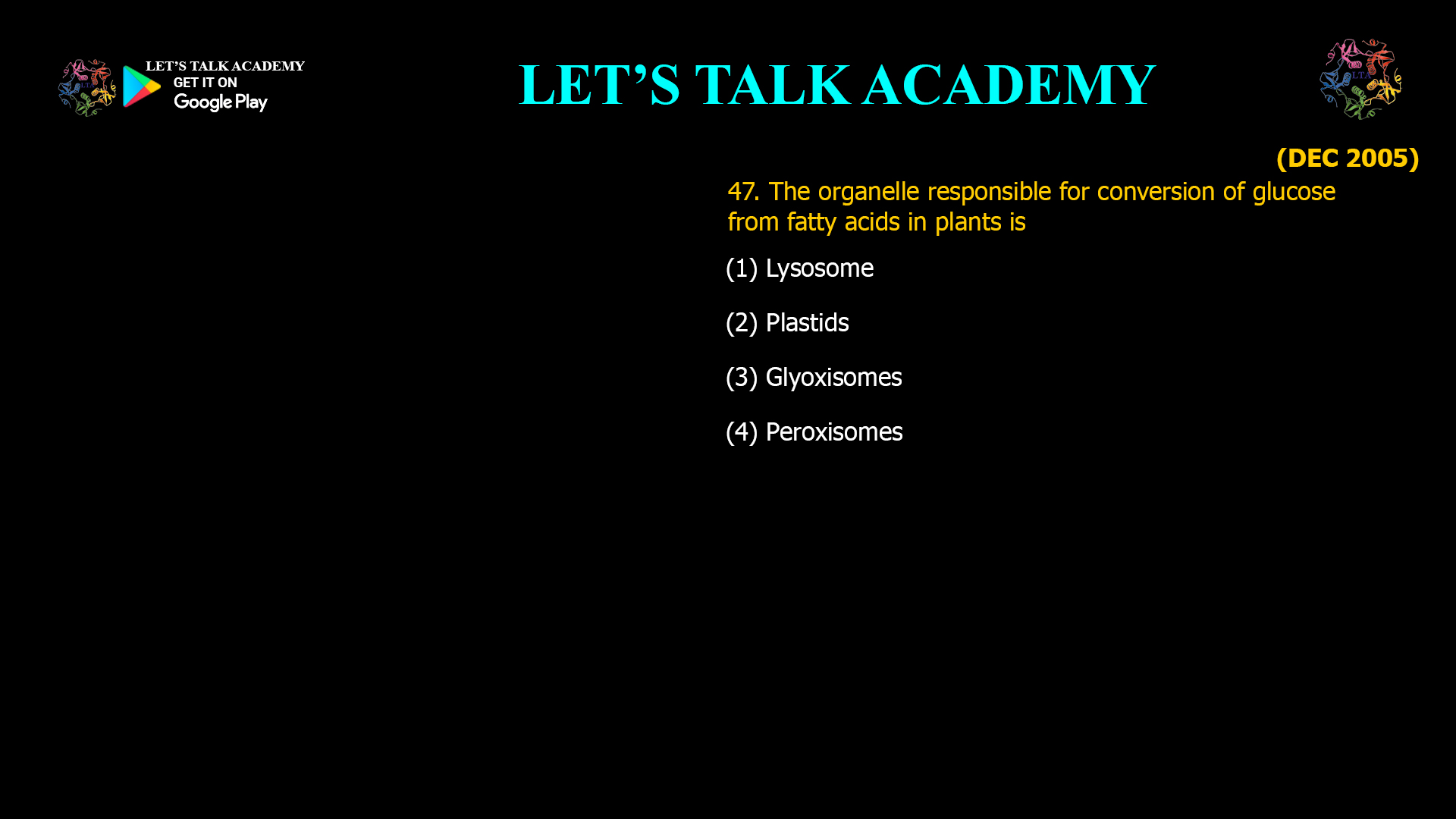- The organelle responsible for conversion of glucose from fatty acids in plants is
(1) Lysosome (2) Plastids
(3) Glyoxisomes (4) Peroxisomes
In plants, the ability to convert fatty acids into glucose is a vital metabolic adaptation that supports growth and survival during periods when carbohydrates are scarce. This conversion occurs through a specialized metabolic pathway known as the glyoxylate cycle, which takes place in a unique organelle called the glyoxysome.
This article explores the role of glyoxysomes in plant metabolism, explaining how they facilitate the transformation of fatty acids into glucose and why this process is crucial for plants.
Understanding the Challenge: Fatty Acids to Glucose
Fatty acids are broken down into acetyl-CoA units through β-oxidation. However, the direct conversion of acetyl-CoA into glucose is biochemically impossible in animals because the carbons from acetyl-CoA are lost as CO₂ in the citric acid cycle, preventing net glucose formation.
Plants, however, have evolved a workaround through the glyoxylate cycle, which bypasses the decarboxylation steps of the citric acid cycle, enabling the net synthesis of glucose from acetyl-CoA derived from fatty acids.
What Are Glyoxysomes?
-
Glyoxysomes are specialized peroxisome-like organelles found in plant cells, particularly abundant in oil-storing seeds.
-
They house enzymes necessary for the glyoxylate cycle, including isocitrate lyase and malate synthase, which are absent in animal cells.
-
Glyoxysomes coordinate fatty acid β-oxidation and the glyoxylate cycle, linking lipid breakdown to carbohydrate synthesis.
The Glyoxylate Cycle: Bypassing Carbon Loss
The glyoxylate cycle modifies the citric acid cycle by bypassing the two decarboxylation steps that release CO₂, allowing the conservation of carbon atoms for glucose synthesis.
-
Acetyl-CoA combines with glyoxylate to form malate via malate synthase.
-
Malate is then converted to oxaloacetate, which enters gluconeogenesis to produce glucose.
-
This cycle enables plants to convert stored lipids into sugars during seed germination or periods of carbohydrate scarcity.
Why Glyoxysomes Are Essential for Glucose Formation from Fatty Acids
-
Glyoxysomes provide the compartmentalization necessary for the glyoxylate cycle enzymes to function efficiently.
-
They ensure the integration of fatty acid degradation and gluconeogenesis pathways.
-
Without glyoxysomes, plants would be unable to convert fatty acids into glucose, limiting their ability to survive during early growth stages before photosynthesis is fully operational.
Other Organelles and Their Roles
-
Plastids: Involved mainly in photosynthesis and fatty acid synthesis but not in converting fatty acids to glucose.
-
Peroxisomes: General sites for fatty acid β-oxidation but lack the glyoxylate cycle enzymes.
-
Lysosomes: Primarily involved in degradation of macromolecules, not in metabolic conversions like gluconeogenesis.
Summary Table
Organelle Role in Fatty Acid to Glucose Conversion Presence of Glyoxylate Cycle Enzymes Function Glyoxysomes Yes Yes Site of glyoxylate cycle and β-oxidation Plastids No No Photosynthesis and fatty acid synthesis Peroxisomes No (general β-oxidation) No Fatty acid β-oxidation without glyoxylate cycle Lysosomes No No Macromolecule degradation Conclusion
The organelle responsible for the conversion of glucose from fatty acids in plants is the glyoxysome. This specialized organelle enables the glyoxylate cycle, a unique pathway that allows plants to bypass carbon loss in the citric acid cycle and synthesize glucose from fatty acid-derived acetyl-CoA.
Correct answer: (3) Glyoxisomes
-




23 Comments
Kirti Agarwal
September 18, 2025Glyoxisomes
Neha Yadav
September 20, 2025The organelle responsible for the conversion of glucose from fatty acids in plants is the glyoxisomes
Bhawna Choudhary
September 21, 2025Glyoxisome
Sonal Nagar
September 22, 2025Glyoxisomes.
Aafreen Khan
September 23, 2025Glyoxisomes are specialized peroxisomes found in plants responsible for conversion of glucose from fatty acid
Dharmpal Swami
September 23, 2025Glyoxisomes present in plant which are responsible for conversion of glucose from fatty acid
Pallavi Ghangas
September 23, 2025glyoxysome
Aakansha sharma Sharma
September 23, 2025Glyoxisomes
Roopal Sharma
September 24, 2025Glyoxisomes
Deepika sheoran
September 24, 2025Glyoxisomes
Nilofar Khan
September 24, 2025The organelle responsible for the conversion of glucose from fatty acids in plants is the glyoxisomes
Minal Sethi
September 24, 2025Glyoxysomes
Priti khandal
September 24, 2025Glyoxisome
Manisha choudhary
September 24, 2025Glycoxysome
Manily occur in oil stored seed
Bypass the carbon loss
Like modified peroxysome
But in peroxysome -not glyoxylate enzyme
HIMANI FAUJDAR
September 24, 2025Ans Glyoxisomes plays important role in the conversation of fatty acid into glucose in plants through a specialized metabolic pathway known as glyoxylate.
Mohd juber Ali
September 25, 2025Glyoxisomes responsible for the conversion of glucose from fatty acids in plants . Glyoxisomes is specialized peroxisome found in plant
Avni
September 26, 2025The organelle responsible for the conversion of glucose from fatty acids in plants is the glyoxisome.
Varsha Tatla
September 27, 2025Glyoxisome
Arushi Saini
September 27, 2025The organelle responsible for the conversion of glucose from fatty acids in plants is the glyoxysome.
Kajal
October 1, 2025Glyoxysome
Muskan Yadav
October 3, 2025The organelle responsible for the conversion of glucose from fatty acids in plants is the glyoxysome.
Santosh Saini
October 5, 2025The organelle responsible for conversion of glucose from fatty acid in plants is the glyoxysome through the glyoxylate metabolic pathway
Khushi Vaishnav
October 7, 2025Glyoxisomes is responsible for the conversion of glucose from fatty acids in plants